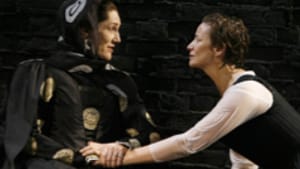Stay in the Loop
BSR publishes on a weekly schedule, with an email newsletter every Wednesday and Thursday morning. There’s no paywall, and subscribing is always free.
Dueling diva queens
Schiller's "Mary Stuart' on Broadway

Trailing clouds of glory from London, Mary Stuart arrived on Broadway with its two acclaimed English stars, Janet McTeer and Harriet Walter, supported by an able American cast. Friedrich Schiller's historical drama about dueling diva queens was written in 1800 about the events of 1587, but it's been polished by translator/adaptor Peter Oswald to a contemporary shine.
The logic of this current revival, so spectacularly received both in New York and abroad, is almost immediately apparent with a thus-was-it-ever weight. The terrifying combination of religion and politics— with its entourage of suicidal fanatics, shrewd plotters and sweet-talking betrayers, a world based on guile and self-interest at the highest levels for the highest stakes— all sounds chillingly familiar.
The court of Elizabeth I (Harriet Walter) is haunted and threatened by the imprisoned Mary Stuart (Janet McTeer), the Scottish Queen, whose claim to the throne has some legitimacy (Henry VIII's vexing will wrote first this child and then that child in and then out of favor). Even more troubling, Mary is Roman Catholic in newly Protestant England, with her disaffected fellow believers fomenting revolution. Add to this Mary's reputation as "a second Helen," beautiful and passionate, with legions of men ready to die to save her.
Different treatment for women
Chief among Mary's former lovers was the Earl of Leicester (the splendidly and charmingly oily John Benjamin Hickey), who is now Elizabeth's favorite. Chief among the besotted Catholic extremists is young Mortimer (Chandler Williams), who, having converted while in Italy under the spell of great religious art, vows to save Mary.
The clever conceit director Phyllida Lloyd devises to highlight the gender wars that (inevitably?) underlie religious wars is to dress the two queens in full Renaissance costumes— Elizabeth the steely Virgin in black-and-gold regalia, Mary a full-bodied sensualist in bare feet— surrounded by men in suits (literally) with colorless ties, eyeglasses, briefcases and leather shoes. A jury of a woman's peers is, despite the requirement of English law, unavailable.
A distant mirror
Elizabeth's advisors provide the full spectrum: cruel to kind, shrewd to wise, scheming to surprised, although she herself realizes that it is the people— often merely a misled, panicked mob whose collective angry voice we hear — who possess the power ("Slave to my own free people"). The play is filled with lines that resonate in our times. As Elizabeth's best counselor, Shrewsbury (Brian Murray) tells her, "They may have voted you this right by a majority. But a majority is not justice. England is not the world. Your Parliament is not the Parliament of the entire human race. Nor is today's England tomorrow's England or yesterday's." Or, as the irked French envoy says, "diplomacy is cockfight."
The set (by Anthony Ward who also designed the costumes) is formidable by its lack: It consists of a huge black wall, an ominous doorway, a certain slant of light. There is a spectacular rainstorm, a coup de théatre that speaks much meaning as McTeer's Mary frolics in a delusive moment of freedom, delighting in getting soaked, until Elizabeth shows up with a full complement of umbrellas and the rain suddenly stops.
The problem of distance
Despite the play's title, this production belongs to Elizabeth. Walter is superb and subtle and winning as Elizabeth: a woman whose self-containment looks rigid but conceals torment. And although McTeer (whose Nora in A Doll's House thrilled Broadway in 1997) is a powerful presence onstage, she is so actorly in her wide arm flings and head tosses and voice swoops that it's difficult to be moved by Mary's plight.
Even more distancing is Lloyd's direction: The play is performed almost entirely in profile; the actors, dwarfed by the huge stage and vast distances between them, speak facing each other, making the audience strain to hear the complex dialogue, so that we feel—except when we are cast as Elizabeth's subjects— outside these monumental events. The power of the original production, in London's tiny Donmar Warehouse, must have been immense. ïµ
The logic of this current revival, so spectacularly received both in New York and abroad, is almost immediately apparent with a thus-was-it-ever weight. The terrifying combination of religion and politics— with its entourage of suicidal fanatics, shrewd plotters and sweet-talking betrayers, a world based on guile and self-interest at the highest levels for the highest stakes— all sounds chillingly familiar.
The court of Elizabeth I (Harriet Walter) is haunted and threatened by the imprisoned Mary Stuart (Janet McTeer), the Scottish Queen, whose claim to the throne has some legitimacy (Henry VIII's vexing will wrote first this child and then that child in and then out of favor). Even more troubling, Mary is Roman Catholic in newly Protestant England, with her disaffected fellow believers fomenting revolution. Add to this Mary's reputation as "a second Helen," beautiful and passionate, with legions of men ready to die to save her.
Different treatment for women
Chief among Mary's former lovers was the Earl of Leicester (the splendidly and charmingly oily John Benjamin Hickey), who is now Elizabeth's favorite. Chief among the besotted Catholic extremists is young Mortimer (Chandler Williams), who, having converted while in Italy under the spell of great religious art, vows to save Mary.
The clever conceit director Phyllida Lloyd devises to highlight the gender wars that (inevitably?) underlie religious wars is to dress the two queens in full Renaissance costumes— Elizabeth the steely Virgin in black-and-gold regalia, Mary a full-bodied sensualist in bare feet— surrounded by men in suits (literally) with colorless ties, eyeglasses, briefcases and leather shoes. A jury of a woman's peers is, despite the requirement of English law, unavailable.
A distant mirror
Elizabeth's advisors provide the full spectrum: cruel to kind, shrewd to wise, scheming to surprised, although she herself realizes that it is the people— often merely a misled, panicked mob whose collective angry voice we hear — who possess the power ("Slave to my own free people"). The play is filled with lines that resonate in our times. As Elizabeth's best counselor, Shrewsbury (Brian Murray) tells her, "They may have voted you this right by a majority. But a majority is not justice. England is not the world. Your Parliament is not the Parliament of the entire human race. Nor is today's England tomorrow's England or yesterday's." Or, as the irked French envoy says, "diplomacy is cockfight."
The set (by Anthony Ward who also designed the costumes) is formidable by its lack: It consists of a huge black wall, an ominous doorway, a certain slant of light. There is a spectacular rainstorm, a coup de théatre that speaks much meaning as McTeer's Mary frolics in a delusive moment of freedom, delighting in getting soaked, until Elizabeth shows up with a full complement of umbrellas and the rain suddenly stops.
The problem of distance
Despite the play's title, this production belongs to Elizabeth. Walter is superb and subtle and winning as Elizabeth: a woman whose self-containment looks rigid but conceals torment. And although McTeer (whose Nora in A Doll's House thrilled Broadway in 1997) is a powerful presence onstage, she is so actorly in her wide arm flings and head tosses and voice swoops that it's difficult to be moved by Mary's plight.
Even more distancing is Lloyd's direction: The play is performed almost entirely in profile; the actors, dwarfed by the huge stage and vast distances between them, speak facing each other, making the audience strain to hear the complex dialogue, so that we feel—except when we are cast as Elizabeth's subjects— outside these monumental events. The power of the original production, in London's tiny Donmar Warehouse, must have been immense. ïµ
What, When, Where
Mary Stuart. By Friedrich Schiller, in a new version by Peter Oswald; directed by Phyllida Lloyd. Through August 16, 2009 at Broadhurst Theatre, 235 W. 44th St., New York. (212) 239-6200 or www.telecharge.com.
Sign up for our newsletter
All of the week's new articles, all in one place. Sign up for the free weekly BSR newsletters, and don't miss a conversation.

 Toby Zinman
Toby Zinman